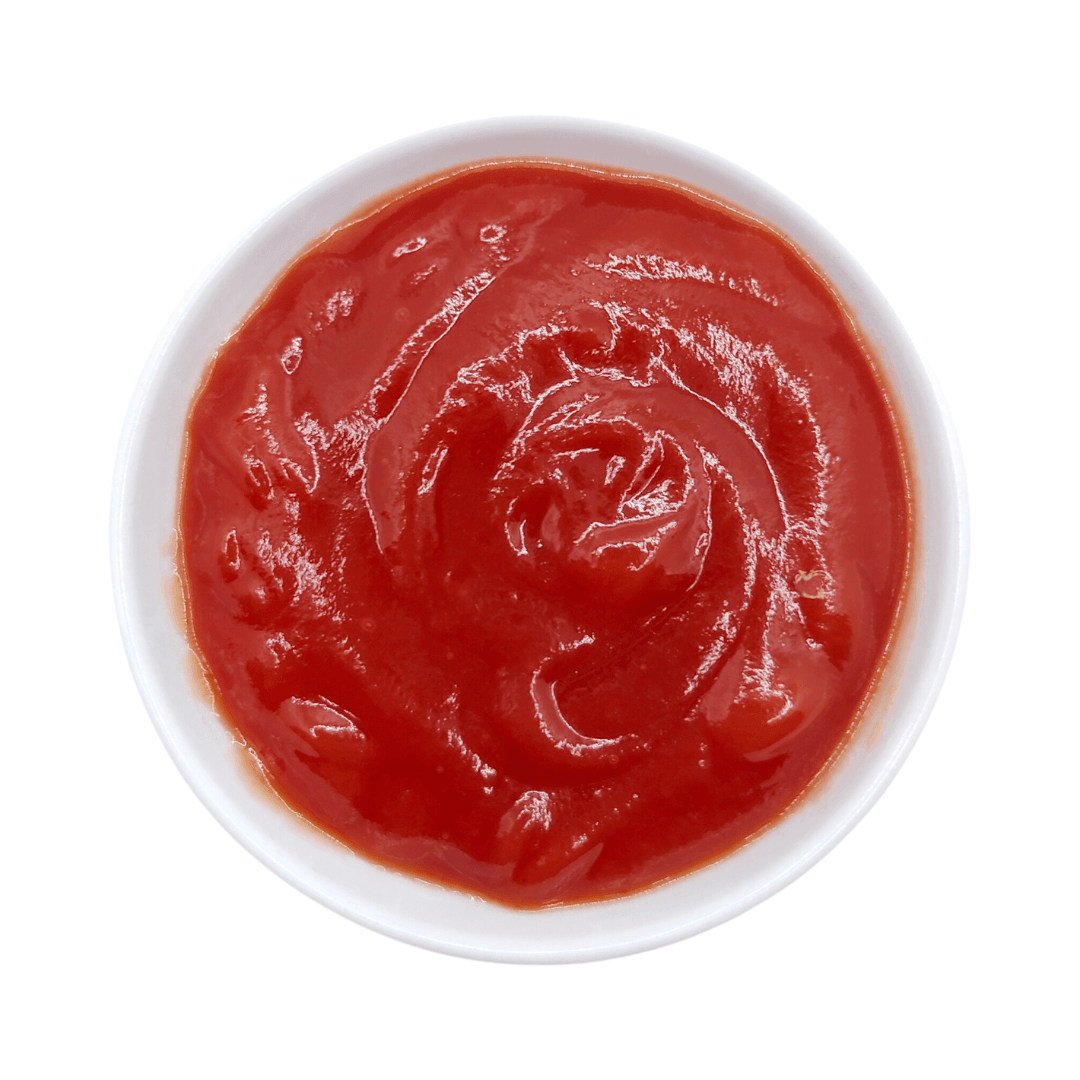If you find yourself nodding in agreement, then you’re in for a treat! Imagine whipping up your own batch of that iconic Taco Bell sauce right in the comfort of your kitchen.
How to make Taco Bell Sauce
Taco Bell sauce refers to the various flavored sauces served with Taco Bell menu items such as tacos, burritos, and nachos. These sauces typically enhance the flavor of the food by adding spice, tanginess, or sweetness.
Ingredients:
- 1 (8-ounce) can of tomato sauce
- 1/3 cup water
- 2 tablespoons vinegar (white or apple cider vinegar work well)
- 1 tablespoon chili powder
- 1 1/2 teaspoons cumin
- 1 1/2 teaspoons onion powder
- 1 teaspoon garlic powder
- 1/2 teaspoon paprika (use smoked paprika for a deeper flavor)
- 1/2 teaspoon cayenne pepper (adjust according to your heat preference)
- 1 teaspoon sugar
- 1/2 teaspoon salt
- 1/4 teaspoon mace (optional for a slightly sweet, nutmeg-like flavor)
- 1/2 teaspoon dried minced onion (optional for texture)
Instructions:
- Combine Ingredients: In a medium saucepan, combine the tomato sauce, water, and vinegar. Stir well to ensure the mixture is smooth. Then, add the chili powder, cumin, onion powder, garlic powder, paprika, cayenne pepper, sugar, salt, and mace if using. Add the dried minced onion if you like a bit of texture in your sauce.
- Simmer: Heat the saucepan over medium heat until the mixture comes to a light simmer. Then, reduce the heat to low. Allow the sauce to simmer gently for 15-20 minutes, stirring occasionally. The simmering process helps the flavors meld together and intensify.
- Adjust to Taste: Taste the sauce and adjust the seasoning if needed. If it’s too spicy, add more sugar or tomato sauce to tone it down. If you prefer it spicier, a touch more cayenne pepper or even a splash of hot sauce can kick it up a notch.
- Cool and Store: After simmering, remove the saucepan from the heat and let the sauce cool to room temperature. Once cooled, transfer the sauce to a blender and pulse a few times for a smoother texture if desired. Then, refrigerate the sauce in an airtight container or jar. The sauce will develop more flavor as it sits, so if you can wait, give it a day before using.
Tips for Making Taco Bell Sauce at Home:
- Flavor Development: Like many sauces, this copycat Taco Bell sauce improves with time. Allowing it to rest in the fridge for at least a day before using can enhance its depth and flavor profile.
- Consistency Adjustments: Add a tablespoon or two of water for a thinner sauce until you reach your desired consistency. Conversely, if the sauce is too thin for your liking, allow it to simmer a bit longer on the stove to reduce and thicken.
- Ingredient Substitutions: Don’t be afraid to tweak the ingredients to suit your palate better. The recipe above aims to capture the essence of Taco Bell’s hot sauce; however, personalization is key to achieving your perfect sauce blend.
- Serving Suggestions: While designed for tacos, this versatile sauce can enrich various dishes. Use it as a dip, a marinade, or a topping for burgers, chicken, vegetables, and more.
What to serve with
Homemade Taco Bell sauce is incredibly versatile. With just a drizzle or dollop, it can transform a simple meal into something spectacular.
Traditional Mexican Fare
- Tacos: Beyond question, tacos and Taco Bell sauce are a match made in heaven. Whether you prefer soft flour tortillas or the crunchiness of hard shells, adding this sauce complements beef, chicken, or veggie fillings.
- Burritos and Burrito Bowls: Smother your bean, rice, and meat-stuffed burritos with Taco Bell sauce for an extra kick. If you’re into burrito bowls, a generous drizzle of sauce will tie all the components together beautifully.
- Quesadillas: Take your cheese quesadillas to the next level by serving them with a side of Taco Bell sauce for dipping. It’s also fantastic drizzled inside the quesadilla before cooking.
- Nachos: Elevate your nacho game by sprinkling this sauce over layers of chips, cheese, jalapeños, and beans before baking. The sauce adds a spicy, tangy touch that works wonders with melted cheese.
American Classics
- Burgers: Add a unique twist to your burgers by mixing Taco Bell sauce into your ground beef mixture or by using it as a condiment. It’s a surefire way to spice up a backyard BBQ.
- Fries: Plain fries can be transformed with a side of Taco Bell sauce for dipping, or you can go the extra mile and create loaded fries topped with cheese, bacon, green onions, and a generous drizzling of your sauce.
- Grilled Cheese: For an unexpected flavor boost, incorporate a bit of the sauce inside your grilled cheese sandwich, or use it as a sophisticated dipping sauce.
Breakfast Dishes
- Eggs: Adding Taco Bell sauce introduces a flavorful twist from scrambled eggs to omelettes. It’s particularly good in breakfast burritos or alongside huevos rancheros.
- Hash Browns: Turn ordinary hash browns into a spicy breakfast treat with a side of Taco Bell sauce for dipping.
Snacks and Sides
- Popcorn: Shake up your movie night by sprinkling some Taco Bell sauce over freshly popped popcorn for an exciting spicy twist.
- Vegetable Sticks: For a healthy snack, serve raw vegetables like carrots, celery, and cucumber with Taco Bell sauce as a zesty dip.
Ingredients Substitutes
Creating a homemade version of Taco Bell sauce is not only fun, but it also allows you to adjust ingredients to suit your taste preferences or accommodate dietary restrictions.
Tomato Paste
Substitute: If you don’t have tomato paste, you can use canned tomato sauce or puree. However, as tomato paste is more concentrated, you may need to reduce it on the stove to thicken and intensify the flavors. Ketchup can be used as a quick alternative, though it will add a sweeter flavor.
Water
Substitute: Water is the simplest ingredient and doesn’t typically need substitution. However, you can use vegetable or chicken broth for a deeper flavour.
Vinegar
Substitute: The original recipe often calls for white vinegar, but you can substitute it with apple cider vinegar for a slightly fruitier tang. Lemon or lime juice can also work in a pinch, providing the necessary acidity.
Jalapeño Juice
Substitute: If you don’t have jalapeño juice on hand, you can process a few slices of jarred jalapeños with a small amount of vinegar or water. Alternatively, use a dash of your favorite hot sauce for the spice component.
Chili Powder
Substitute: If you are out of chili powder, make a mix using ground-dried chilis, garlic powder, onion powder, paprika, and cumin. Adjust the proportions based on what’s available in your pantry.
Sugar
Substitute: To tweak sweetness, you can use honey, agave syrup, or even maple syrup instead of sugar. These will add a slightly different flavor profile but achieve the same balance of sweetness.
Salt
Substitute: In most cases, simple table salt works best, but for a different touch or dietary preferences, you can explore sea salt or reduced-sodium salt options.
Onion Powder
Substitute: If onion powder is not available, finely grated fresh onion or shallots can work. Alternatively, use freshly chopped green onions as part of the mix.
Garlic Powder
Substitute: Freshly minced garlic or a small amount of garlic salt (reduce the additional salt to balance) can substitute for garlic powder. As a last resort, a tiny amount of asafetida can mimic garlic’s pungency in recipes.
Cayenne Pepper
Substitute: Any ground hot pepper will work, such as paprika (for less heat) or a pinch of ground habanero (for more heat). Red pepper flakes, if ground finely, can also be a good substitute.
Xanthan Gum (for thickening)
Substitute: This ingredient is optional but helps replicate the sauce’s texture. You can use cornstarch or arrowroot powder as alternatives. Both must be mixed with a little cold water and added to the sauce mixture while heating to activate thickening.
Cumin
Substitute: Cumin is hard to replace as it offers a uniquely warm and earthy flavor, but a mixture of ground coriander and a bit of caraway seeds can mimic its characteristics in a pinch.
Dry Mustard
Substitute: If dry mustard is unavailable, a small squirt of prepared mustard can work, but it will slightly alter the texture and add vinegar content.
Paprika
Substitute: For color and a sweet peppery flavor, substitute paprika with a similar amount of chili powder or a mix of ground red pepper and a hint of sweetness from sugar.
Final Thoughts
Creating your own Taco Bell sauce at home is not only a fun culinary adventure but also a way to keep those beloved flavors on hand whenever the craving strikes.
More Taco Bell Recipes:
- Copycat Taco Bell Seasoning Recipe
- Taco Bell Chicken Nuggets Sauce Recipe
- Homemade Taco Bell Chicken Nuggets Recipe

Ingredients
- 1 (8-ounce) can of tomato sauce
- 1/3 cup water
- 2 tablespoons vinegar
- 1 tablespoon chili powder
- 1 1/2 teaspoons cumin
- 1 1/2 teaspoons onion powder
- 1 teaspoon garlic powder
- 1/2 teaspoon paprika
- 1/2 teaspoon cayenne pepper
- 1 teaspoon sugar
- 1/2 teaspoon salt
- 1/4 teaspoon mace
- 1/2 teaspoon dried minced onion
Instructions
- Combine Ingredients: In a medium saucepan, combine the tomato sauce, water, and vinegar. Stir well to ensure the mixture is smooth. Then, add the chili powder, cumin, onion powder, garlic powder, paprika, cayenne pepper, sugar, salt, and mace if using. Add the dried minced onion if you like a bit of texture in your sauce.
- Simmer: Heat the saucepan over medium heat until the mixture comes to a light simmer. Then, reduce the heat to low. Allow the sauce to simmer gently for 15-20 minutes, stirring occasionally. The simmering process helps the flavors meld together and intensify.
- Adjust to Taste: Taste the sauce and adjust the seasoning if needed. If it's too spicy, add more sugar or tomato sauce to tone it down. If you prefer it spicier, a touch more cayenne pepper or even a splash of hot sauce can kick it up a notch.
- Cool and Store: After simmering, remove the saucepan from the heat and let the sauce cool to room temperature. Once cooled, transfer the sauce to a blender and pulse a few times for a smoother texture if desired. Then, refrigerate the sauce in an airtight container or jar. The sauce will develop more flavor as it sits, so if you can wait, give it a day before using.









